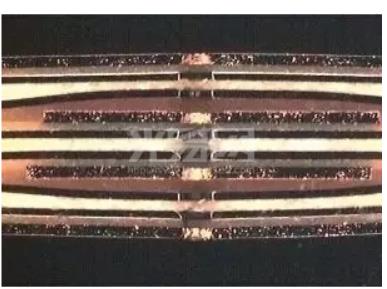다양한 PCB 소재에 나노초 UV 레이저 적용
Aug 17 , 2022Application of nanosecond UV laser in various PCB materials
Ultraviolet lasers are the best choice for various PCB material applications in many industrial fields, from the production of the most basic circuit boards, circuit wiring, to advanced processes such as the production of pocket-sized embedded chips. This material difference makes UV lasers the best choice for a variety of PCB material applications in many industrial fields, from the production of the most basic circuit boards, circuit wiring, to advanced processes such as the production of pocket-sized embedded chips.
Application 1: Surface Etching/Circuit Production
Ultraviolet lasers work quickly in the production of circuits, etching surface patterns onto circuit boards in minutes. This makes UV lasers the fastest way to produce PCB samples. The R&D department has noticed that more and more sample laboratories are being equipped with in-house UV laser systems.
Depending on optical instrument characterization, the size of the UV laser beam can reach 10-20 μm to produce flexible circuit traces. The application in Figure 2 shows the greatest advantage of UV light in producing circuit traces that are so tiny they need to be seen under a microscope.
The board measures 0.75" x 0.5" and consists of a sintered ceramic substrate and tungsten/nickel/copper/surface. The laser is capable of producing circuit traces of 2 mils with 1 mil pitch, resulting in an overall pitch of only 3 mils.
While using a laser beam to produce circuits is the fastest method for PCB samples, large-scale surface etching applications are best left to chemical processes.
Application 2: Disassembly of PCB
UV laser cutting is the best choice for large or small production, and it is also a good choice for PCB disassembly, especially when it needs to be applied to flexible or rigid-flex circuit boards. Disassembly is the removal of a single circuit board from a panel, which can be challenging given the ever-increasing flexibility of materials.
Mechanical disassembly methods such as V-groove cutting and automatic circuit board cutting can easily damage sensitive and thin substrates, causing trouble for electronic manufacturing services (EMS) companies when disassembling flexible and rigid-flex circuit boards.
자외선 레이저 절단은 모서리 가공, 변형 및 회로 부품 손상과 같은 분해 과정에서 기계적 응력의 영향을 제거할 수 있을 뿐만 아니라 CO2 레이저 절단과 같은 다른 레이저보다 열 응력이 적습니다.
"컷 범퍼"의 감소는 공간을 절약합니다. 즉, 구성 요소를 트레이스의 가장자리에 더 가깝게 배치할 수 있으므로 각 보드에 더 많은 트레이스가 들어갈 수 있으므로 효율성이 극대화되고 유연한 회로 애플리케이션의 최대 한계에 도달할 수 있습니다.
응용 3: 드릴링 구멍
UV 레이저의 작은 빔 크기와 낮은 스트레스 특성을 활용하는 또 다른 응용 분야는 관통, 마이크로 및 블라인드 매립 비아를 포함한 드릴링입니다. UV 레이저 시스템은 기판을 직선으로 절단하기 위해 수직 빔을 집중시켜 구멍을 뚫습니다. 사용된 재료에 따라 10μm만큼 작은 구멍을 뚫을 수 있습니다.
자외선 레이저는 다층 드릴링에 특히 유용합니다. 다층 PCB는 복합 재료를 사용하여 함께 핫 다이 캐스트됩니다. 이러한 소위 "반경화"는 특히 더 뜨거운 레이저로 가공한 후에 분리될 수 있습니다. 그러나 상대적으로 응력이 없는 UV 레이저의 특성은 그림 4와 같이 이 문제를 해결합니다.
표시된 단면에서 14mil 다층 보드에 4mil 직경의 구멍이 뚫려 있습니다. 유연한 폴리이미드 구리 코팅 기판에 대한 이 적용은 층 사이에 분리가 없음을 보여줍니다. UV 레이저의 낮은 스트레스 특성에 대한 또 다른 중요한 점은 향상된 수율 데이터입니다. 수율은 패널에서 제거된 사용 가능한 회로 기판의 백분율입니다.
다양한 PCB 재료에 UV 레이저 적용
제조 공정 중에 납땜 접합부 파손, 구성 요소 균열 또는 박리를 비롯한 여러 조건으로 인해 회로 기판이 손상될 수 있습니다. 두 가지 요인으로 인해 보드가 생산 라인의 배송 상자 대신 쓰레기통에 버려질 수 있습니다.
응용 4: 깊은 조각
UV 레이저의 다재다능함을 보여주는 또 다른 응용 분야는 다양한 형태를 포괄하는 깊은 조각입니다. 레이저 시스템의 소프트웨어 제어를 사용하여 레이저 빔은 제어된 절제, 즉 원하는 깊이에서 재료를 절단하고, 중지하고, 계속하고, 다른 깊이로 전환하고 다른 작업 처리를 시작하기 전에 원하는 깊이를 완료하는 기능에 대해 설정됩니다.
다양한 심층 응용 분야에는 칩 임베딩을 위한 소규모 생산 및 금속 표면에서 유기 물질을 제거하기 위한 표면 연삭이 포함됩니다.
UV 레이저는 또한 기판에서 다단계 작업을 수행할 수 있습니다. 폴리에틸렌 재질에 1단계는 레이저를 이용하여 깊이 2mils의 홈을 만들고, 2단계는 앞선 단계를 기준으로 8mils의 홈을 만들고, 3단계는 홈을 10밀. 이것은 UV 레이저 시스템이 제공하는 전반적인 사용자 제어를 보여줍니다.

결론: 보편적인 접근 방식
UV 레이저의 가장 눈에 띄는 특징은 이러한 모든 응용 분야를 단일 단계로 수행할 수 있다는 것입니다. 이것은 회로 기판을 만드는 데 무엇을 의미합니까? 애플리케이션을 완성하기 위해 서로 다른 장비에서 동시에 영향력 있는 프로세스와 방법을 사용하는 대신 단일 가공 작업으로 완전한 부품을 얻을 수 있습니다.
이 능률적인 생산 접근 방식은 보드가 서로 다른 프로세스 간에 이동할 때 발생하는 품질 관리 문제를 제거하는 데 도움이 됩니다. UV 파편이 없는 제거 속성은 또한 후처리 세척이 필요하지 않음을 의미합니다.